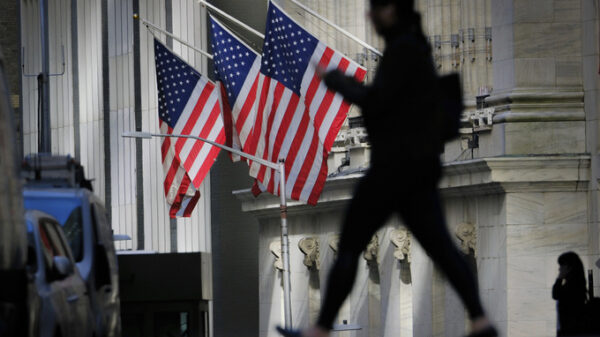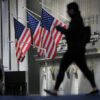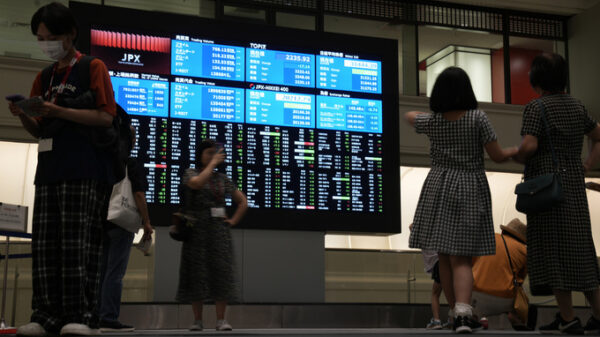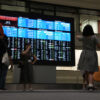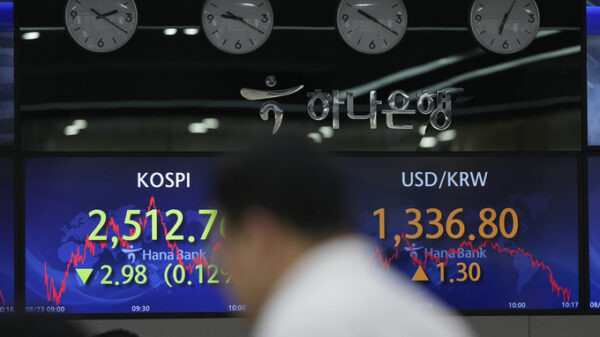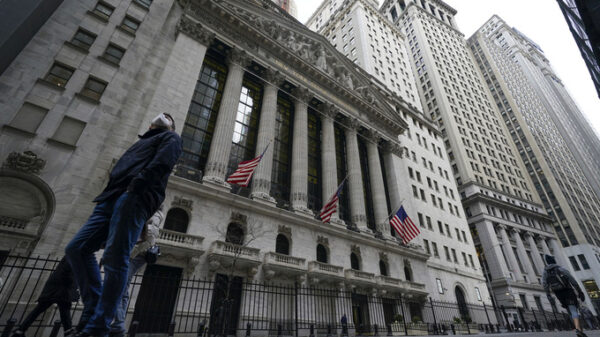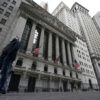Men wearing masks against the spread of the coronavirus stand near an electronic stock board showing Japan’s Nikkei 225 index at a securities firm in Tokyo Monday, Nov. 16, 2020. Shares started out the week on a strong footing after the Standard & Poors 500 hit a fresh high on Friday, with strong data from Japan and China fueling optimism over economic recoveries even as coronavirus caseloads surpass earlier records.(AP Photo/Eugene Hoshiko)
Stock markets jumped higher on Monday on news that a second coronavirus vaccine showed promise, bolstering hopes even as new infections surged around the world.
Pharmaceutical company Moderna said its vaccine appears to be 94.5% effective, according to preliminary data. Markets rallied as they did when Pfizer and BioNTech said earlier this month that their vaccine had a similar effectiveness rate.
The future for the Dow was up 1.6%, or 470 points, while that for the S&P 500, which had closed at a record high on Friday, was up 1%, or 34.60 points.
Germany’s DAX climbed 1.3% to 13,246 and the CAC 40 in Paris jumped 2.5% to 5,512. In Britain, the FTSE 100 advanced 1.8% to 6,4304.
Dr. Stephen Hoge, Moderna’s president said that having similar results from two different companies is reassuring. While approval for the vaccine can come within weeks, the rollout of the drug will take more time.
Even before the vaccine news, markets had been trading higher as investors welcomed the signing on Sunday of an agreement establishing the world’s biggest trade bloc, a group of 15 countries that includes China, Japan, South Korea, 10 countries in Southeast Asia, New Zealand and Australia. The United States, the No. 1 economy, is not a part of it.
Called the Regional Comprehensive Economic Partnership, the pact mostly will bring already low tariffs lower over a 20-year period. It is expected to have a positive but incremental impact on trade in the region.
“The fact that the agreement got over the line after eight years of negotiation between a widely disparate group of nations is an achievement in itself,” Jeffrey Halley of Oanda said in a commentary. “That has left the Asia-Pacific with a feeling that there is life in the world, with or without the United States.”
Meanwhile, data released Monday showed Japan, the world’s third largest economy, grew at a upbeat 21% annual pace in the last quarter, the first quarter of growth in nearly a year.
Tokyo’s Nikkei 225 jumped 2.1% to 25,906.93 and the Hang Seng in Hong Kong picked up 0.9% to 26,381.67. The Kospi in South Korea surged 2% to 2,543.03 and in Australia the S&P/ASX 200 advanced 1.2% to 6,484.30. The Shanghai Composite index gained 1.1% to 3,346.97.
The Japanese data, while strong, was distorted by the size of the earlier declines, noted Robert Carnell of ING Economics, adding “the economy contracted 28.8% in the second quarter of 2020 and still remains well below pre-COVID levels.”
In quarterly terms, the 7.9% contraction in April-June was followed by a rebound of 5%.
“Japan had a slightly stronger than expected bounce-back in the third quarter, but not meaningfully better in the context of the massive swings we are seeing in economic activity,” Carnell said.
China’s factory output rose 6.9% over a year earlier in October, holding steady at September’s rate, government data showed Monday. Retail sales gained 4.3% over a year ago, up 1 percentage point from the previous month.
In other trading, benchmark U.S. crude oil gained $1.56 to $41.69 per barrel in electronic trading on the New York Mercantile Exchange. It lost 99 cents to $40.13 on Friday. Brent crude, the international standard, picked up $1.59 to $44.37 per barrel.
The dollar edged up to 104.90 Japanese yen from 104.65 yen. The euro rose to $1.1845 from $1.1836.
AP Business Writers Joe McDonald in Beijing and Yuri Kageyama in Tokyo contributed.
Copyright 2020 Associated Press. All rights reserved.



































